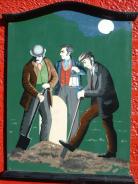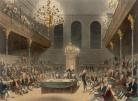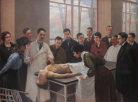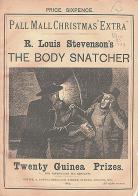Rhylee Greer's Timeline for "The Body Snatcher"
Created by Rhylee Greer on Sun, 11/14/2021 - 19:37
Part of Group:
"The Body Snatcher" focuses on questioning the ethical meaning behind resurrectionists in order to depict a social issue. Robert Louis Stevenson effectively used historical events and key ideas from the Victorian Era to accurately convey the lack of morals behind body snatching. The Victorian Era was a time of reform, and Stevenson uses this key idea to promote reform for social problems. In this timeline I will be describing historical events from the 19th century that displays the context behind Robert Stevenson's short story, "The Body Snatcher."
Timeline
Chronological table
| Date | Event | Created by | Associated Places | |
|---|---|---|---|---|
| 20 Autumn 1815 |
Post Napoleonic DepressionPost Napoleonic Depression caused distress in several countries including England after the end of the Napoleonic Wars in 1815. The price of food increased due to new Corn Laws that put tariffs and restrictions on imported food. Due to the high supply of food and low demand, wages began to fall. New machinery was placed in the work environment, taking the places of many working men. (Innes) With no work, money, or food, nearly 60,000 people gathered together in order to protest the end of the suffrage on August 16,1819. In order to gain control of the protest, the local cavalry charged into the crowd killing a dozen people and injuring around 600. This is known as the Peterloo Massacre.(BRANCH) The Post Napoleonic Depression caused social unrest between the people and the parliament. Low wages and high cost of living lead to people doing any kind of work, for example, body snatching. The context of the Post Napoleonic Depression explains the reasoning why body snatching was a common job in the 1800s even when it is unethical. Men needed money to provide for their family and survive, and doctors would pay them well. Works Cited: Innes, Ad. A History of British Nation. London, TC and EC Jack, 1912. “Peterloo Massacre | BRANCH.” Branch, www.branchcollective.org/?ps_event=peterloo-massacre. Accessed 17 Nov. 2021. |
Rhylee Greer | ||
| Autumn 1827 to 31 Autumn 1828 |
The Burke and Hare MurdersWilliam Burke and his accomplice William Hare were two resurrectionists, men who steal bodies from grave sites and trade them to doctors for money. Between November 1827 and October 1828, Burke and Hare killed 16 people in Edinburgh, United Kingdom. These bodies were being sold to surgeon Dr. Robert Knox. Hare avoided execution by "informing against William Burke." (BRANCH) Burke was sentenced to death and anatomized. His skeleton was then displayed at the Anatomy Museum at Edinburgh Medical School, where it still is today. (BRANCH) These series of murders where the first killings to spread and gain public attention; this brought awareness for the need of bodies for studies and education. With the widespread of the Burke and Hare murders, the people and the government officials were more drawn into the fact of how unethical the act of body snatching is. Due to this and the loose laws on resurrectionists ,it ultimately led to the Anatomy Act of 1832. You could say the murders influenced Robert Stevenson because of the impact William Hare and William Burke had on this social issue. Works Cited Branch. “Trial of William Burke | BRANCH.” Branch Collective, Branch, www.branchcollective.org/?ps_event=trial-of-william-burke. Accessed 6 Dec. 2021. |
Rhylee Greer | ||
| 7 Summer 1832 |
Reform Act of 1832The Victorian Era was the age of progress; during this time, social problems focused on the working class and poor were addressed. In June 1832 the parliament passed the Reform Act, or also well known as The Representation of the People Act. (Berman)This act intended to represent the people better by expanding the electoral votes. It "broadened the franchise property qualification to include landowners, tenant farmers, and shopkeepers," and "created 67 new constituencies," allowing more people to vote. (Berman) It showed the people that the parliament was listening and proved that change was possible.The Reform Act of 1832 highlights representation of the Victorian Era, the age of reform. Knowing the Victorian Era was a time for change, Stevenson's purpose of "Body Snatcher" is easily understood. The short story addresses a social problem to draw attention to promote reform. Works Cited: Berman, Carolyn. “Carolyn Vellenga Berman, ‘On the Reform Act of 1832’ | BRANCH.” BRANCH, Mar. 2013, www.branchcollective.org/?ps_articles=carolyn-vellenga-berman-on-the-ref.... |
Rhylee Greer | ||
| 1 Summer 1832 |
Anatomy Act of 1832After the widespread of information on body snatching and resurrectionists, the people began to lose faith in the medical profession because of the lack of morals. In response to the growing profession of trading corpses and the Burke and Hare murders, the parliament passed the Anatomy Act of 1832. This act prevented illegal trade of bodies for dissection and allowed doctors access to corpses that were unclaimed after death.(Lancet) Many of these unclaimed bodies were prisoners, workhouse men, or people whose family could not afford a burial.(Lancet) The Anatomy Act of 1832 shows the mysterious and scary effect to Stevenson's short story. It shows the audience how trading corpses is morally wrong. It also exemplifies reform during the Victorian Era in the England community, a main subject for Stevenson. Works Cited: The Lancet. “British Library.” The British Library, 1832, www.bl.uk/collection-items/issues-of-medical-journal-the-lancet-1831-32\. |
Rhylee Greer | ||
| Winter 1884 |
Publication of "The Body Snatcher"Robert Stevenson vacationed in a Scottish village of Pitlorchy for a couple of summer months in 1881. (Richardson) Many urban legends involving ghosts and resurrectionists were circling in Edinburgh regions, including where Stevenson was settled. In this village, the land lady's daughter would share these stories with Stevenson. (Richardson)He became inspired by these tales and began to develop "The Body Snatcher" a story of ghosts and resurrectionists. With the knowledge of the Burke and Hare murders and the Victorian Era, Stevenson was able to develop a story based off of the murders and Dr. Robert Knox while focusing on key themes of the Victorian Era. The short story was put on hold from publication due to Stevenson's wife Fanny, his "critic on the hearht." (Richardson) She felt in needed "further contemplation" and "the story was felt too good" for a short story. "The Body Snatcher" was finally published in 1884. Works Cited: Richardson, Ruth. “The Lancet.” Art of Medicine, vol. 385, no. 9966, 2015, pp. 412–13. The Lancet, doi:10.1016/S0140-6736(15)60144-1. |
Rhylee Greer |





